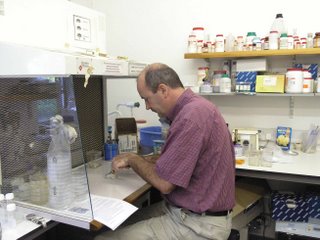
At the top of the hill about five minutes walk from the house is an ancient Roman fort. It is the highest point of land for miles around with views to the ocean and the Sussex Downs. On a clear day you can see both the city of Brighton and Hove and the village of Falmer and the University of Sussex as seen in this photo.

In the city of Brighton is the Royal Pavilion. The pavilion was built in 1802 by the then George, Prince of Wales later to become king George IV. The gardens around the pavilion were designed by John Nash and laid out in the regency style. This style of gardening and plant display is somewhat eclectic in nature with large informal beds of mixed trees, shrubs, perennials, bulbs and annual plantings. The gardens look unkempt since the mown grass is 'loosely mown' emulating how it would have been scythed in the 1800's. In my opinion, after viewing many gardens of an earlier or similar period where they are mown it is just an excuse to save money and time. Nonetheless it is an interesting landscape with uninteresting plants. The graduation ceremony for the postgraduates is held here in January.
http://www.royalpavilion.org.uk/
 On Sunday it was once again a tour around the countryside, this time over a portion of the downs. The Sussex Downs is an area of open grassland and low deep valleys which are usually treed. Once in the open on the downs it is very windy, hence the lack of trees. If you look at the first image and imagine you were in that image inthe top right hand corner looking back you could be standing at this gate at the edge of the woods. This was the most spectacular trip so far, 6 hours of ever changing but dramatic scenery. There are few hills now that will stop me since some of them are several miles in length I am getting a tremendous workout since we figured it was over thirty miles of fairly technical terrain. We finished our trip some six hours later back at the house, however not before stopping at the little cafe on the beach for a cup of tea.
On Sunday it was once again a tour around the countryside, this time over a portion of the downs. The Sussex Downs is an area of open grassland and low deep valleys which are usually treed. Once in the open on the downs it is very windy, hence the lack of trees. If you look at the first image and imagine you were in that image inthe top right hand corner looking back you could be standing at this gate at the edge of the woods. This was the most spectacular trip so far, 6 hours of ever changing but dramatic scenery. There are few hills now that will stop me since some of them are several miles in length I am getting a tremendous workout since we figured it was over thirty miles of fairly technical terrain. We finished our trip some six hours later back at the house, however not before stopping at the little cafe on the beach for a cup of tea.http://www.vic.org.uk/

The beach in Brighton stretches for miles and is mainly pebbles, however along the entire stretch is the promenade where you can walk or cycle. This is in front of the cafe where we stopped for tea at about 6:30pm on Sunday.
Of course I have to put some serious stuff in as well. To prove to my students that school is not all fun and play. Here I am working in the lab (plant stress unit) performing micropropagation (tissue cultures) of a rare endangered British orchid called Da
 ctylorhiza and cultures of a carnivorous plant called Drosera carpensis as well as a few common plants to test for seed coat cleanliness. Over the next few weeks we should see if I was successful with the cultures. This is the only place in the the world where Dactylorhiza is propagated via tissue culture.
ctylorhiza and cultures of a carnivorous plant called Drosera carpensis as well as a few common plants to test for seed coat cleanliness. Over the next few weeks we should see if I was successful with the cultures. This is the only place in the the world where Dactylorhiza is propagated via tissue culture.It is called the plant stress unit since we cut up plants and do all sorts of nasty things to them inflicting stress. Tomorrow, Wednesday, I will intentionally infect the resurrection plant (Craterostigma plantagineum) with cultures of Agrobacterium and study the response. More plant stress, stay tuned!
http://www.biols.susx.ac.uk/resgroups/biology/psu/1_introduction.htm
No comments:
Post a Comment